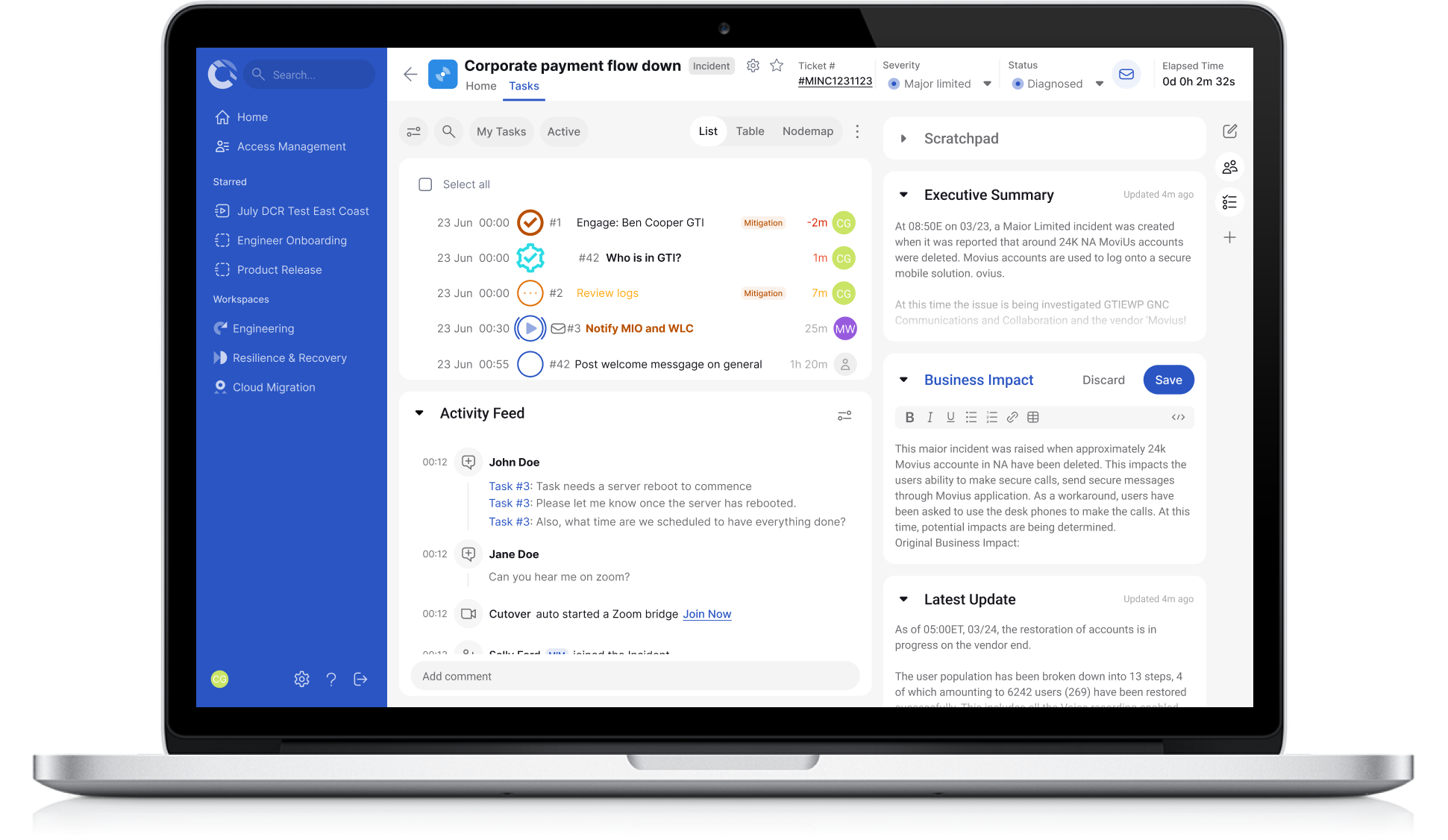


Back to works
#CaseStudy #Enterprise #B2B
Cutover: Incident Management for Operational Resilience
Strengthening resilience by designing scalable workflows and real-time dashboards for mission-critical incident management.
Problem Statement
Financial institutions lacked a clear way to coordinate thousands of tasks during critical incidents, making resilience and real-time collaboration difficult.
Background analysis
For large financial institutions, operational resilience depends on coordinating thousands of interdependent tasks during events like ATM outages or cloud cutovers. Existing workflows relied on fragmented tools and manual processes, which made real-time collaboration slow and error-prone.
To address this, Cutover introduced Runbooks — structured workflows enabling teams to manage incidents with precision.
These allowed tasks to be tracked, dependencies visualized, and progress monitored in real time, ensuring clarity and control in high-stakes environments.
Design Process
Identification
Mapped pain points in existing incident workflows, focusing on coordination gaps during critical events.
Research
Analyzed enterprise tools and interviewed users and stakeholders to understand how teams manage high-stakes incidents.
Design
Created scalable patterns for Runbooks, task dependencies, and live dashboards through iterative wireframes.
Final Design
Delivered high-fidelity mockups aligned with Cutover branding and optimized for clarity under pressure.
Solution
- Integrated scalable Runbooks to coordinate thousands of interdependent tasks during incidents.
- Designed real-time dashboards to track task progress, dependencies, and alerts with clarity.
- Created flexible workflows to support multi-team collaboration across roles and permissions.
- Balanced information density and usability to ensure teams could act quickly under pressure.
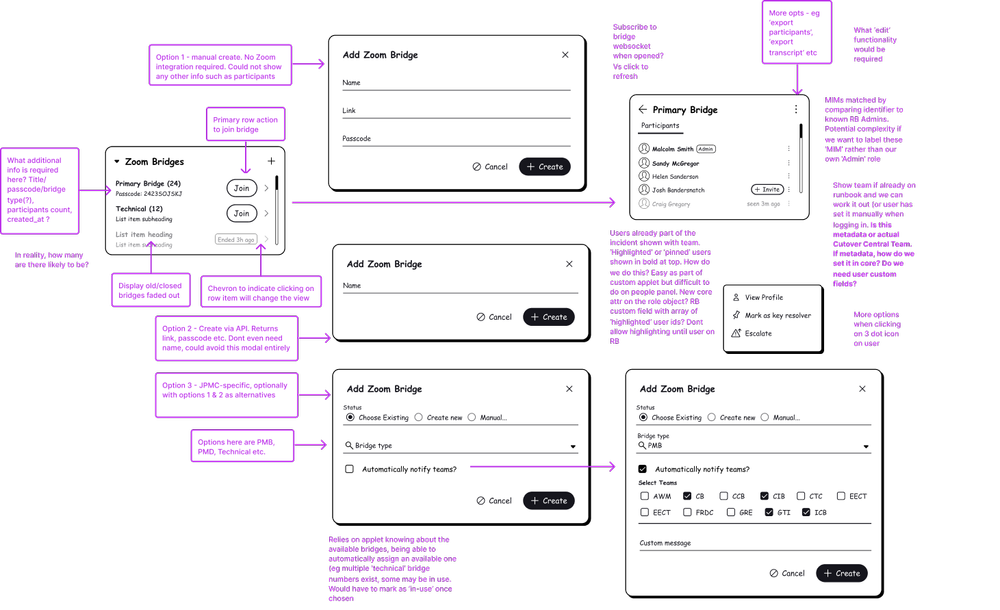
User Personas

Full Name
:
Michael Tan
Age
:
43 years old
Role:
:
Incident Manager
Experience
:
12+ years in IT operations
Tech Proficiency:
:
Advanced (enterprise systems, monitoring tools, workflow automation)
About
Michael oversees critical operations for a multinational bank, including ATM networks and cloud infrastructure.
During incidents, he must coordinate multiple teams under intense pressure, ensuring that tasks are executed in sequence without delays or errors.
His role demands speed, clarity, and resilience to minimize downtime and financial risk.
Goals
- Maintain operational continuity during incidents.
- Track dependencies and task progress in real time.
- Improve cross-team collaboration under pressure.
- Reduce manual errors through standardized workflows.
- Ensure compliance with regulatory requirements.
Frustrations/Pain Points
- Current tools are fragmented and lack real-time visibility.
- Manual coordination is time-consuming and error-prone.
- Information overload makes it difficult to focus on critical tasks.
- Delays in communication increase both risk and downtime.
- Lacks a single source of truth during complex incidents.
Motivations
- Values clarity and transparency in live incident reporting.
- Prefers tools that scale across teams and roles.
- Seeks to reduce downtime and financial loss.
- Appreciates structured workflows that guide teams step by step.
- Wants confidence that the system will perform reliably under stress.

Full Name
:
Priya Nair
Age
:
28 years old
Role:
:
Technical Operator
Experience
:
5+ years in IT operations
Tech Proficiency:
:
Intermediate to Advanced
About
Priya is part of the IT operations team responsible for executing assigned tasks during incidents.
She often joins bridge calls, follows instructions from incident managers, and updates task progress in real time.
Her primary focus is on accuracy and speed, ensuring her updates give managers and executives an up-to-date picture of the situation.
Goals
- Receive clear instructions on what needs to be done.
- Update task status quickly and without friction.
- Reduce confusion when multiple teams are working in parallel.
- Ensure her updates contribute to the single source of truth.
- Minimize downtime by completing her tasks efficiently.
Frustrations/Pain Points
- Tools that require too many steps to update a task.
- Confusion over who owns which task when dependencies are unclear.
- Difficulty filtering what’s relevant to her role.
- Stress increases when communication tools and task systems are not synchronized.
- Lack of visibility into how her completed tasks impact the bigger picture.
Motivations
- Values simple, clear interfaces that reduce errors.
- Wants to feel her work directly impacts operational resilience.
- Appreciates tools that minimize context switching between apps.
- Prefers workflows that don’t overwhelm her with unnecessary details.
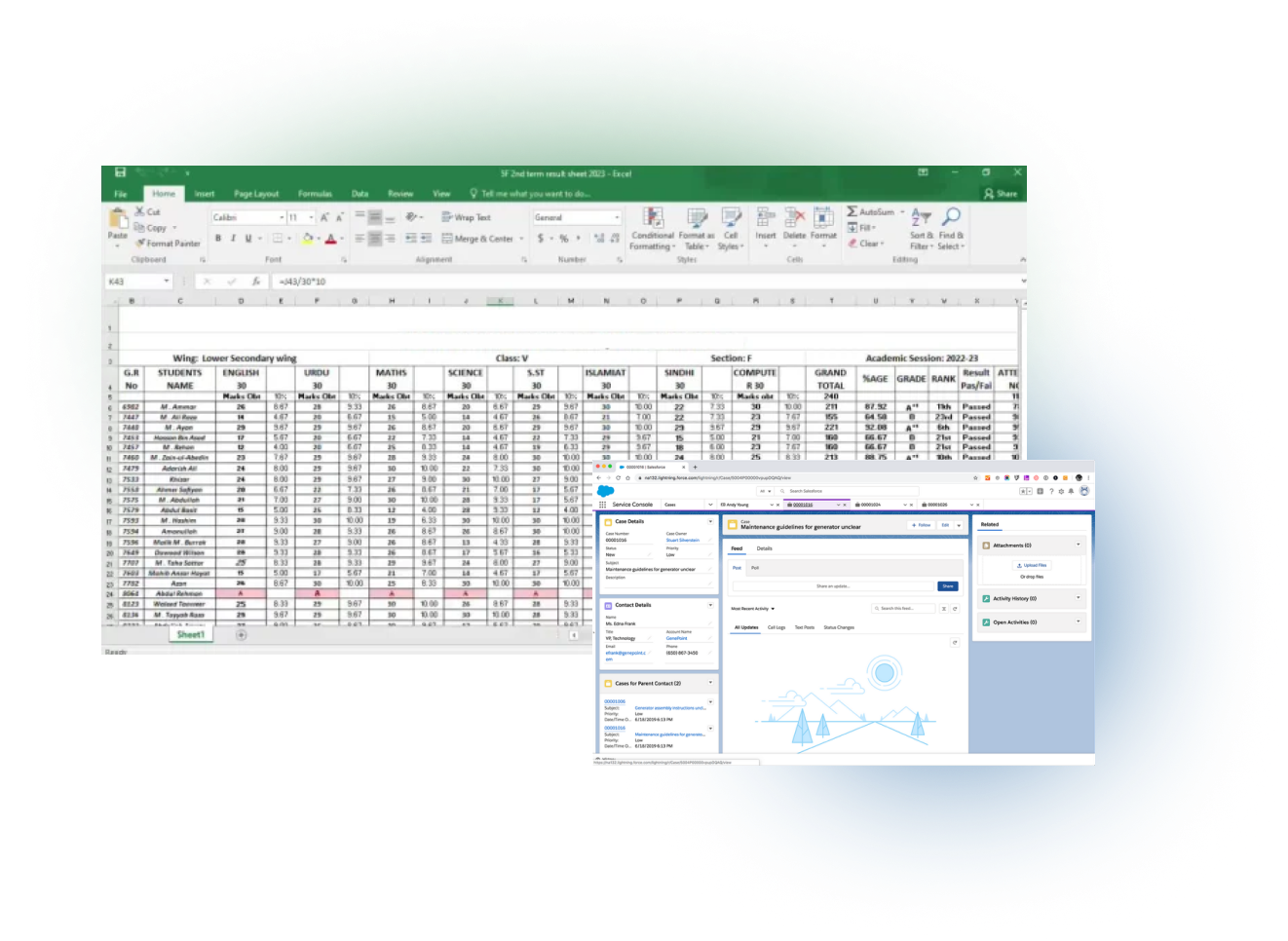
What is good, and what is bad?
The home screen has a playful and engaging design, making it easy for users to quickly join a game—one of the app's most essential features
However, several usability challenges surfaced during testing:
- High information density made it difficult for users to focus on critical alerts.
- Inconsistent visual hierarchy caused confusion when scanning long task lists and dependencies.
- Excessive reliance on manual updates slowed teams down during high-pressure scenarios.
- Fragmented navigation across different modules reduced efficiency and increased training needs.
- Users requested a single source of truth where all updates, tasks, and dependencies could be monitored in one view.
Ideation
During ideation, I explored how to make complex workflows more intuitive for incident managers and operators.
This involved experimenting with collapsible and expandable task modules, visual states for dependencies, and alternative dashboard arrangements.
The key objective was to ensure the interface provided clarity and control under pressure, replacing fragmented tools (e.g., spreadsheets and emails) with a single, streamlined environment that was both scalable and user-friendly.
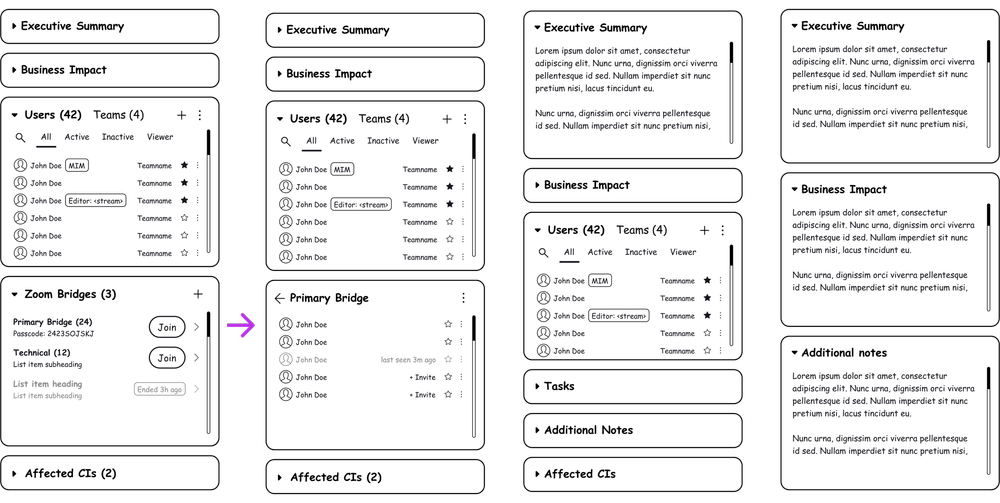

Mockups
During ideation, I explored how to make complex workflows more intuitive for incident managers and operators.
This involved experimenting with collapsible and expandable task modules, visual states for dependencies, and alternative dashboard arrangements.
The key objective was to ensure the interface provided clarity and control under pressure, replacing fragmented tools (e.g., spreadsheets and emails) with a single, streamlined environment that was both scalable and user-friendly.
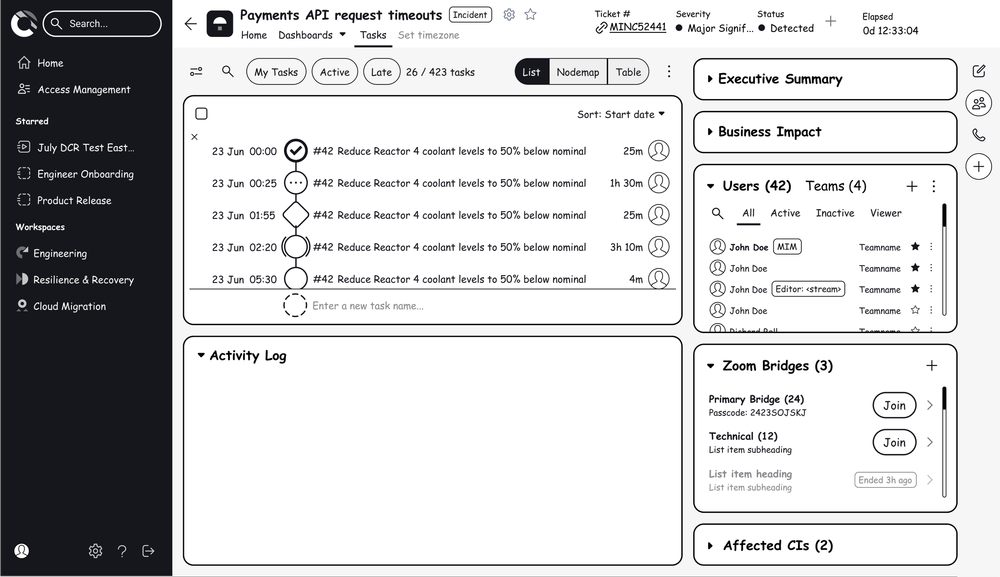
Competitive Analysis




UI Design
To reduce clutter and complexity, I optimized the interface for clarity, speed, and visibility. Inspired by modular design systems, I introduced a customizable dashboard that adapts to different roles and workflows.
Users can personalize their view by pinning preferred modules (e.g., Runbook overview, dependencies, notes) and tailoring fields to their responsibilities. This streamlined the experience, improved situational awareness, and enhanced engagement during high-pressure incidents.
Incident Management UI
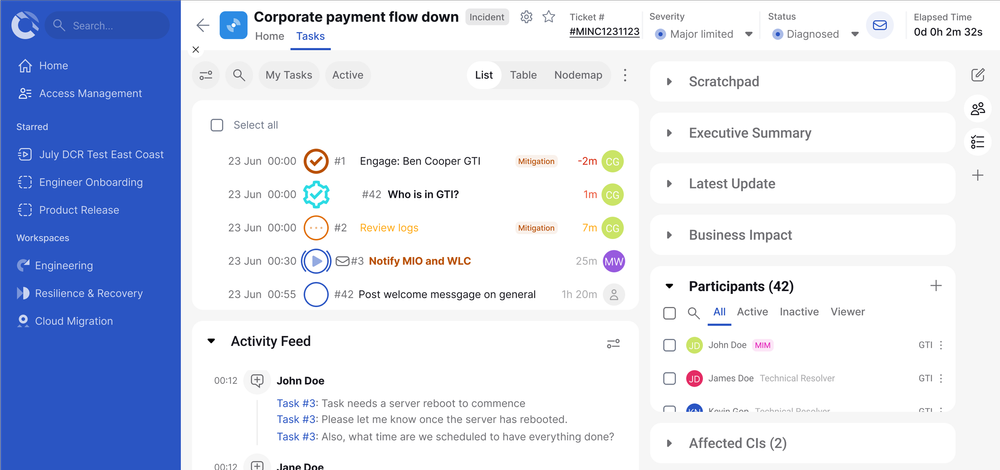
Task List
Dashboard for tracking assigned tasks and their progress in real time.
Activity Feed
Live stream of task updates and communications for full situational awareness.
Incident Status
Clear view of severity, state, and elapsed time during ongoing incidents.
Pods
Modular components that display key information such as summaries, impacts, and participant updates.

Integrations List
Seamlessly connect with external systems to synchronize data and workflows.
+55%
increase
in task updates completed on time during incidents
+37%
improvement
in cross-team visibility via real-time dashboards
-28%
reduction
in incident resolution time for high-severity cases
Conclusion
By redesigning incident workflows with clarity and scalability in mind, we created a platform that strengthens resilience and empowers teams to respond with confidence.
Back to works
#CaseStudy #Enterprise #B2B
Cutover: Incident Management for Operational Resilience
Strengthening resilience by designing scalable workflows and real-time dashboards for mission-critical incident management.



Problem Statement
Financial institutions lacked a clear way to coordinate thousands of tasks during critical incidents, making resilience and real-time collaboration difficult.
Background analysis
For large financial institutions, operational resilience depends on coordinating thousands of interdependent tasks during events like ATM outages or cloud cutovers. Existing workflows relied on fragmented tools and manual processes, which made real-time collaboration slow and error-prone.
To address this, Cutover introduced Runbooks — structured workflows enabling teams to manage incidents with precision.
These allowed tasks to be tracked, dependencies visualized, and progress monitored in real time, ensuring clarity and control in high-stakes environments.
Design Process
Identification
Mapped pain points in existing incident workflows, focusing on coordination gaps during critical events.
Research
Analyzed enterprise tools and interviewed users and stakeholders to understand how teams manage high-stakes incidents.
Design
Created scalable patterns for Runbooks, task dependencies, and live dashboards through iterative wireframes.
Final Design
Delivered high-fidelity mockups aligned with Cutover branding and optimized for clarity under pressure.
Solution
- Integrated scalable Runbooks to coordinate thousands of interdependent tasks during incidents.
- Designed real-time dashboards to track task progress, dependencies, and alerts with clarity.
- Created flexible workflows to support multi-team collaboration across roles and permissions.
- Balanced information density and usability to ensure teams could act quickly under pressure.

User Personas

Full Name
:
Michael Tan
Age
:
43 years old
Role:
:
Incident Manager
Experience
:
12+ years in IT operations
Tech Proficiency:
:
Advanced (enterprise systems, monitoring tools, workflow automation)
About
Michael oversees critical operations for a multinational bank, including ATM networks and cloud infrastructure.
During incidents, he must coordinate multiple teams under intense pressure, ensuring that tasks are executed in sequence without delays or errors.
His role demands speed, clarity, and resilience to minimize downtime and financial risk.
Goals
- Maintain operational continuity during incidents.
- Track dependencies and task progress in real time.
- Improve cross-team collaboration under pressure.
- Reduce manual errors through standardized workflows.
- Ensure compliance with regulatory requirements.
Frustrations/Pain Points
- Current tools are fragmented and lack real-time visibility.
- Manual coordination is time-consuming and error-prone.
- Information overload makes it difficult to focus on critical tasks.
- Delays in communication increase both risk and downtime.
- Lacks a single source of truth during complex incidents.
Motivations
- Values clarity and transparency in live incident reporting.
- Prefers tools that scale across teams and roles.
- Seeks to reduce downtime and financial loss.
- Appreciates structured workflows that guide teams step by step.
- Wants confidence that the system will perform reliably under stress.

Full Name
:
Priya Nair
Age
:
28 years old
Role:
:
Technical Operator
Experience
:
5+ years in IT operations
Tech Proficiency:
:
Intermediate to Advanced
About
Priya is part of the IT operations team responsible for executing assigned tasks during incidents.
She often joins bridge calls, follows instructions from incident managers, and updates task progress in real time.
Her primary focus is on accuracy and speed, ensuring her updates give managers and executives an up-to-date picture of the situation.
Goals
- Receive clear instructions on what needs to be done.
- Update task status quickly and without friction.
- Reduce confusion when multiple teams are working in parallel.
- Ensure her updates contribute to the single source of truth.
- Minimize downtime by completing her tasks efficiently.
Frustrations/Pain Points
- Tools that require too many steps to update a task.
- Confusion over who owns which task when dependencies are unclear.
- Difficulty filtering what’s relevant to her role.
- Stress increases when communication tools and task systems are not synchronized.
- Lack of visibility into how her completed tasks impact the bigger picture.
Motivations
- Values simple, clear interfaces that reduce errors.
- Wants to feel her work directly impacts operational resilience.
- Appreciates tools that minimize context switching between apps.
- Prefers workflows that don’t overwhelm her with unnecessary details.

What is good, and what is bad?
The home screen has a playful and engaging design, making it easy for users to quickly join a game—one of the app's most essential features
However, several usability challenges surfaced during testing:
- High information density made it difficult for users to focus on critical alerts.
- Inconsistent visual hierarchy caused confusion when scanning long task lists and dependencies.
- Excessive reliance on manual updates slowed teams down during high-pressure scenarios.
- Fragmented navigation across different modules reduced efficiency and increased training needs.
- Users requested a single source of truth where all updates, tasks, and dependencies could be monitored in one view.
Ideation
During ideation, I explored how to make complex workflows more intuitive for incident managers and operators.
This involved experimenting with collapsible and expandable task modules, visual states for dependencies, and alternative dashboard arrangements.
The key objective was to ensure the interface provided clarity and control under pressure, replacing fragmented tools (e.g., spreadsheets and emails) with a single, streamlined environment that was both scalable and user-friendly.

Mockups
During ideation, I explored how to make complex workflows more intuitive for incident managers and operators.
This involved experimenting with collapsible and expandable task modules, visual states for dependencies, and alternative dashboard arrangements.
The key objective was to ensure the interface provided clarity and control under pressure, replacing fragmented tools (e.g., spreadsheets and emails) with a single, streamlined environment that was both scalable and user-friendly.

Competitive Analysis




UI Design
To reduce clutter and complexity, I optimized the interface for clarity, speed, and visibility. Inspired by modular design systems, I introduced a customizable dashboard that adapts to different roles and workflows.
Users can personalize their view by pinning preferred modules (e.g., Runbook overview, dependencies, notes) and tailoring fields to their responsibilities. This streamlined the experience, improved situational awareness, and enhanced engagement during high-pressure incidents.

Incident Management UI
Task List
Dashboard for tracking assigned tasks and their progress in real time.
Activity Feed
Live stream of task updates and communications for full situational awareness.
Incident Status
Clear view of severity, state, and elapsed time during ongoing incidents.
Pods
Modular components that display key information such as summaries, impacts, and participant updates.
Integrations List
Seamlessly connect with external systems to synchronize data and workflows.
Conclusion
By redesigning incident workflows with clarity and scalability in mind, we created a platform that strengthens resilience and empowers teams to respond with confidence.
+55%
increase
task updates completed on time during incidents
+37%
improvement
in cross-team visibility via real-time dashboards
-28%
reduction
in incident resolution time for high-severity cases
Back to works
Back to works
#CaseStudy #Enterprise #B2B
Cutover: Incident Management for Operational Resilience
Strengthening resilience by designing scalable workflows and real-time dashboards for mission-critical incident management.



Problem Statement
Financial institutions lacked a clear way to coordinate thousands of tasks during critical incidents, making resilience and real-time collaboration difficult.
Background analysis
For large financial institutions, operational resilience depends on coordinating thousands of interdependent tasks during events like ATM outages or cloud cutovers. Existing workflows relied on fragmented tools and manual processes, which made real-time collaboration slow and error-prone.
To address this, Cutover introduced Runbooks — structured workflows enabling teams to manage incidents with precision.
These allowed tasks to be tracked, dependencies visualized, and progress monitored in real time, ensuring clarity and control in high-stakes environments.
Design Process
Identification
Mapped pain points in existing incident workflows, focusing on coordination gaps during critical events.
Research
Analyzed enterprise tools and interviewed users and stakeholders to understand how teams manage high-stakes incidents.
Design
Created scalable patterns for Runbooks, task dependencies, and live dashboards through iterative wireframes.
Final Design
Delivered high-fidelity mockups aligned with Cutover branding and optimized for clarity under pressure.
Solution
- Integrated scalable Runbooks to coordinate thousands of interdependent tasks during incidents.
- Designed real-time dashboards to track task progress, dependencies, and alerts with clarity.
- Created flexible workflows to support multi-team collaboration across roles and permissions.
- Balanced information density and usability to ensure teams could act quickly under pressure.

User Personas

Full Name
:
Michael Tan
Age
:
43 years old
Role:
:
Incident Manager
Experience
:
12+ years in IT operations
Tech Proficiency:
:
Advanced (enterprise systems, monitoring tools, workflow automation)
About
Michael oversees critical operations for a multinational bank, including ATM networks and cloud infrastructure.
During incidents, he must coordinate multiple teams under intense pressure, ensuring that tasks are executed in sequence without delays or errors.
His role demands speed, clarity, and resilience to minimize downtime and financial risk.
Goals
- Maintain operational continuity during incidents.
- Track dependencies and task progress in real time.
- Improve cross-team collaboration under pressure.
- Reduce manual errors through standardized workflows.
- Ensure compliance with regulatory requirements.
Motivations
- Values clarity and transparency in live incident reporting.
- Prefers tools that scale across teams and roles.
- Seeks to reduce downtime and financial loss.
- Appreciates structured workflows that guide teams step by step.
- Wants confidence that the system will perform reliably under stress.
Frustrations/Pain Points
- Current tools are fragmented and lack real-time visibility.
- Manual coordination is time-consuming and error-prone.
- Information overload makes it difficult to focus on critical tasks.
- Delays in communication increase both risk and downtime.
- Lacks a single source of truth during complex incidents.

Full Name
:
Priya Nair
Age
:
28 years old
Role:
:
Technical Operator
Experience
:
5+ years in IT operations
Tech Proficiency:
:
Intermediate to Advanced
About
Priya is part of the IT operations team responsible for executing assigned tasks during incidents.
She often joins bridge calls, follows instructions from incident managers, and updates task progress in real time.
Her primary focus is on accuracy and speed, ensuring her updates give managers and executives an up-to-date picture of the situation.
Goals
- Receive clear instructions on what needs to be done.
- Update task status quickly and without friction.
- Reduce confusion when multiple teams are working in parallel.
- Ensure her updates contribute to the single source of truth.
- Minimize downtime by completing her tasks efficiently.
Motivations
- Values simple, clear interfaces that reduce errors.
- Wants to feel her work directly impacts operational resilience.
- Appreciates tools that minimize context switching between apps.
- Prefers workflows that don’t overwhelm her with unnecessary details.
Frustrations/Pain Points
- Tools that require too many steps to update a task.
- Confusion over who owns which task when dependencies are unclear.
- Difficulty filtering what’s relevant to her role.
- Stress increases when communication tools and task systems are not synchronized.
- Lack of visibility into how her completed tasks impact the bigger picture.

What is good, and what is bad?
The home screen has a playful and engaging design, making it easy for users to quickly join a game—one of the app's most essential features
However, several usability challenges surfaced during testing:
- High information density made it difficult for users to focus on critical alerts.
- Inconsistent visual hierarchy caused confusion when scanning long task lists and dependencies.
- Excessive reliance on manual updates slowed teams down during high-pressure scenarios.
- Fragmented navigation across different modules reduced efficiency and increased training needs.
- Users requested a single source of truth where all updates, tasks, and dependencies could be monitored in one view.
Ideation
During ideation, I explored how to make complex workflows more intuitive for incident managers and operators.
This involved experimenting with collapsible and expandable task modules, visual states for dependencies, and alternative dashboard arrangements.
The key objective was to ensure the interface provided clarity and control under pressure, replacing fragmented tools (e.g., spreadsheets and emails) with a single, streamlined environment that was both scalable and user-friendly.


Mockups
During ideation, I explored how to make complex workflows more intuitive for incident managers and operators.
This involved experimenting with collapsible and expandable task modules, visual states for dependencies, and alternative dashboard arrangements.
The key objective was to ensure the interface provided clarity and control under pressure, replacing fragmented tools (e.g., spreadsheets and emails) with a single, streamlined environment that was both scalable and user-friendly.
Competitive Analysis




UI Design
To reduce clutter and complexity, I optimized the interface for clarity, speed, and visibility. Inspired by modular design systems, I introduced a customizable dashboard that adapts to different roles and workflows.
Users can personalize their view by pinning preferred modules (e.g., Runbook overview, dependencies, notes) and tailoring fields to their responsibilities. This streamlined the experience, improved situational awareness, and enhanced engagement during high-pressure incidents.

Incident Management UI
Incident Status
Clear view of severity, state, and elapsed time during ongoing incidents.
Pods
Modular components that display key information such as summaries, impacts, and participant updates.
Integrations List
Seamlessly connect with external systems to synchronize data and workflows.
Activity Feed
Live stream of task updates and communications for full situational awareness.
Task List
Dashboard for tracking assigned tasks and their progress in real time.
+55%
increase
in task updates completed on time during incidents
+37%
improvement
in cross-team visibility via real-time dashboards
-28%
reduction
in incident resolution time for high-severity cases
Conclusion
By redesigning incident workflows with clarity and scalability in mind, we created a platform that strengthens resilience and empowers teams to respond with confidence.
Back to works